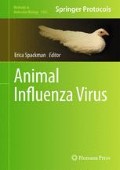Abstract
Avian influenza virus and some mammalian influenza A viruses are usually isolated, propagated, and titrated in embryonated chicken eggs (ECE). Most any sample type can be accommodated for culture with appropriate processing. Isolation may also be accomplished in cell culture particularly if mammalian lineage isolates are suspected, for example, swine influenza in turkey specimens. Culture is highly sensitive, but is not specific for influenza A, which may be an advantage because a sample may be screened for several agents at once. Once an agent is isolated in culture, the presence of influenza viruses is confirmed with any of several assays. The methods for propagating virus isolates in ECE are described.
Access this chapter
Tax calculation will be finalised at checkout
Purchases are for personal use only
References
Moresco KA, Stallknecht DE, Swayne DE (2010) Evaluation and attempted optimization of avian embryos and cell culture methods for efficient isolation and propagation of low pathogenicity avian influenza viruses. Avian Dis 54:622–626
Moresco KA, Stallknecht DE, Swayne DE (2012) Evaluation of different embryonating bird eggs and cell cultures for isolation efficiency of avian influenza A virus and avian paramyxovirus serotype 1 from real-time reverse transcription polymerase chain reaction-positive wild bird surveillance samples. J Vet Diagn Invest 24:563–567
Lira J, Moresco KA, Stallknecht DE, Swayne DE, Fisher DS (2010) Single and combination diagnostic test efficiency and cost analysis for detection and isolation of avian influenza virus from wild bird cloacal swabs. Avian Dis 54:606–612
Woolcock PR, Suarez DL, Kuney D (2003) Low-pathogenicity avian influenza virus (H6N2) in chickens in California, 2000–02. Avian Dis 47:872–881
Swayne DE, Senne D, Suarez DL (2008) Avian influenza, Chapter 29. In: Dufour-Zavala L et al (eds) Isolation and identification of avian pathogens, 5th edn. American Association of Avian Pathologists, Jacksonville, FL, p 128–134. Chapter 29. Avian influenza
Suarez DL, Spackman E, Senne DA, Bulaga L, Welsch AC, Froberg K (2003) The effect of various disinfectants on detection of avian influenza virus by real time RT-PCR. Avian Dis 47:1091–1095
World Organization for Animal Health (2012) Avian influenza in manual of diagnostic tests and vaccines for terrestrial animals. http://www.oie.int/fileadmin/Home/eng/Health_standards/tahm/2.03.04_AI.pdf
Reed LJ, Muench H (1938) A simple method for estimating fifty percent endpoints. Am J Hyg 27:493–497
Erickson GA, Brugh M, Beard CW (1978) Newcastle disease and avian influenza virus stability under simulated shipping conditions. 21st annual meeting of American Association of Veterinary Laboratory Diagnosticians, Buffalo, NY, 31 Oct–3 Nov 1978
Spackman E, Pedersen JC, McKinley ET, Gelb J Jr (2013) Optimal specimen collection and transport methods for the detection of avian influenza virus and newcastle disease virus. BMC Vet Res 9:35
Author information
Authors and Affiliations
Corresponding author
Editor information
Editors and Affiliations
Rights and permissions
Copyright information
© 2014 Springer Science+Business Media New York
About this protocol
Cite this protocol
Spackman, E., Killian, M.L. (2014). Avian Influenza Virus Isolation, Propagation, and Titration in Embryonated Chicken Eggs. In: Spackman, E. (eds) Animal Influenza Virus. Methods in Molecular Biology, vol 1161. Humana Press, New York, NY. https://doi.org/10.1007/978-1-4939-0758-8_12
Download citation
DOI: https://doi.org/10.1007/978-1-4939-0758-8_12
Published:
Publisher Name: Humana Press, New York, NY
Print ISBN: 978-1-4939-0757-1
Online ISBN: 978-1-4939-0758-8
eBook Packages: Springer Protocols

